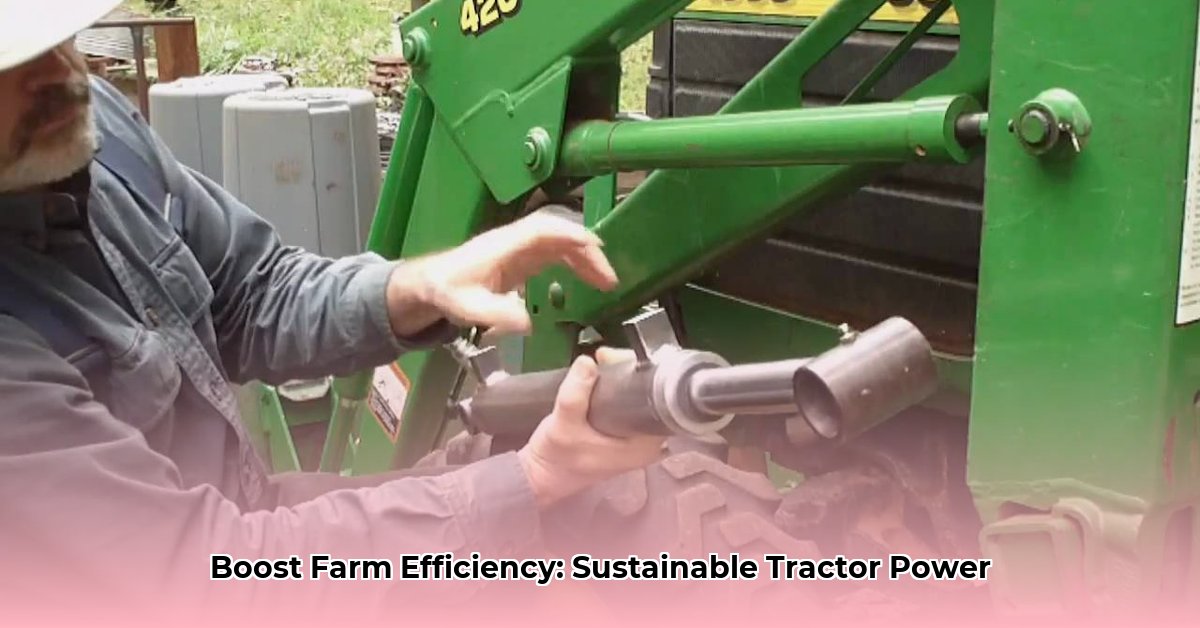
Tractor Front End Loader Cylinders: Building a Greener Future for Farming
Farmers rely heavily on their equipment, and tractor front-end loader cylinders are central to efficient operation. However, the environmental impact of these components is often overlooked. This article explores sustainable solutions for these crucial agricultural tools, examining materials, manufacturing processes, and lifecycle considerations to promote environmentally responsible farming practices. For more information on loader buckets, check out this helpful resource.
The Current State of Tractor Front End Loader Cylinders: A Landscape Overview
Current market offerings encompass a broad range of cylinders varying in size and strength. Typically constructed from durable steel, often with chrome plating for enhanced wear resistance, there's often a lack of transparency regarding the specific materials and manufacturing processes involved. This opacity makes assessing their environmental footprint difficult, hindering sustainable agricultural efforts. Isn't it crucial to understand the full environmental cost of our equipment to truly farm sustainably?
Sustainability in Action: Crafting Greener Cylinders
Creating truly sustainable cylinders requires a holistic approach, considering the entire product lifecycle. This includes:
Material Innovation: Transitioning to recycled steel significantly reduces reliance on virgin materials and minimizes environmental damage associated with extraction. Exploring bio-based polymers for certain components offers further opportunities for sustainable manufacturing.
Manufacturing Optimization: Implementing lean manufacturing principles streamlines production, reducing energy consumption and waste generation. Adopting renewable energy sources during manufacturing further contributes to a reduced carbon footprint. How can we optimize existing processes to maximize efficiency and reduce waste?
Comprehensive Life Cycle Assessment (LCA): Rigorous LCA studies, analyzing the entire product lifecycle from material sourcing to disposal, identify environmental hotspots and guide improvement strategies. This detailed analysis allows for targeted interventions that maximize sustainability.
Extended Product Lifespan: Designing cylinders for easy repair and rebuild extends their operational life, reducing the need for frequent replacements and minimizing material waste. Incorporating advanced seal technologies further enhances longevity and reduces the environmental impact of frequent part replacements.
Taking Action: A Collaborative Approach to Sustainability
Achieving sustainability requires a collective effort from all stakeholders.
Table 1: Collaborative Actions for Sustainable Cylinders
| Stakeholder | Short-Term Actions (Within 1 Year) | Long-Term Goals (3-5 Years and Beyond) |
|---|---|---|
| Equipment Manufacturers (OEMs) | Partner with sustainable material suppliers; conduct comprehensive LCAs; improve warranty programs. | Design for inherent sustainability; implement comprehensive cylinder recycling programs; proactive LCA integration. |
| Parts Suppliers | Increase transparency in material sourcing and manufacturing; offer extended warranties. | Research and utilize sustainable materials; conduct LCAs; establish partnerships with recycling facilities. |
| Farmers | Prioritize durable, repairable cylinders; adopt preventative maintenance programs. | Implement sustainable farming practices; optimize cylinder usage to maximize lifespan. |
| Governments & Regulatory Bodies | Offer financial incentives (grants, tax breaks) for sustainable manufacturing. | Develop and enforce regulations establishing minimum environmental standards for agricultural equipment. |
Understanding the Challenges: Navigating Obstacles to Sustainability
Transitioning to sustainable practices isn't without challenges. Addressing potential risks is vital for successful implementation.
Table 2: Mitigating Risks to Achieve Sustainability
| Technology/Practice | Potential Risks | Mitigation Strategies |
|---|---|---|
| Recycled Materials | Potential inconsistencies in material quality | Rigorous quality control; careful supplier selection; advanced material testing protocols. |
| Bio-based Hydraulic Fluids | Compatibility issues with existing systems | Thorough testing; close system monitoring; development of compatible system components. |
| Extended Warranties | Higher initial costs for manufacturers and consumers | Improved manufacturing processes; government incentives for sustainable practices. |
| Recycling Infrastructure Gaps | Limited recycling infrastructure | Public-private partnerships; government investment; improved consumer education and awareness. |
| Higher Upfront Costs | Increased initial investment for sustainable options | Government subsidies; emphasis on long-term cost savings of sustainable practices; financial modeling. |
The Future of Sustainable Tractor Front End Loader Cylinders: A Vision for Tomorrow
The future of sustainable agricultural equipment is bright. Advancements in seal technology, modular designs for easier repair, and biodegradable hydraulic fluids are on the horizon. A collaborative approach, combining innovation with a commitment to environmentally responsible practices, is key to building a sustainable agricultural future.
How to Choose Sustainable Hydraulic Cylinders for Agricultural Equipment
Choosing sustainable hydraulic cylinders requires a comprehensive approach, balancing performance with environmental responsibility. This necessitates examining several key aspects of the cylinder's lifecycle.
Prioritizing Sustainability: Beyond the Buzzword
A truly sustainable cylinder prioritizes durability and longevity, minimizing the need for frequent replacements and reducing the overall environmental burden. This means considering:
Material Sourcing: Selection of cylinders manufactured with recycled steel or sustainably sourced materials directly lessens the demand for new material extraction and associated environmental impacts.
Energy Efficiency: Energy-efficient designs reduce both fuel consumption and greenhouse gas emissions during operation.
Lifecycle Considerations: Analyzing the entire lifecycle, encompassing manufacturing, use, maintenance, and disposal, informs informed decisions that support circular economy principles.
Choosing Your Sustainable Cylinder: A Practical Guide
Define Needs: Accurately assess your specific application demands (lifting capacity, pressure, stroke length) to avoid over-specifying and wasting resources.
Select Materials: Favor cylinders made from recycled steel or other sustainable materials; seek certifications confirming responsible sourcing.
Prioritize Energy Efficiency: Select designs minimizing hydraulic fluid usage and energy losses. Look for innovative friction reduction mechanisms and optimized fluid flow designs.
Consider Lifecycle: Evaluate the cylinder's complete lifespan, ensuring longevity and ease of repair to reduce the need for replacements. Extended warranties indicate manufacturer confidence.
Manufacturer Transparency: Choose manufacturers with explicit sustainability policies and commitments to responsible manufacturing.
Focus on Maintenance: Choose cylinders designed for straightforward maintenance and repair, extending lifespan and minimizing waste.
Embracing a Sustainable Future
The agricultural equipment sector is evolving towards sustainability. New materials, advanced sealing technologies, and smarter designs are paving the way for truly environmentally responsible cylinders. By embracing these advancements, farmers can optimize both efficiency and environmental stewardship.